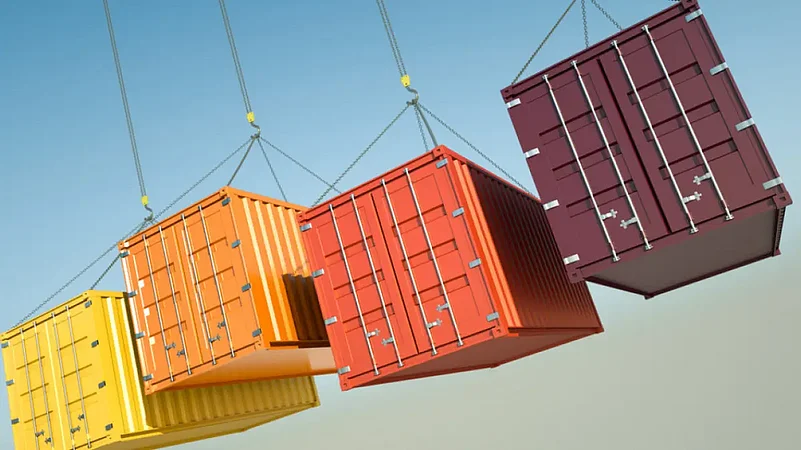The soaring current account deficit and fiscal deficit in 2022 posed a formidable challenge before India. In its monthly economic review in June 2022, the Ministry of Finance spoke about India’s “twin deficit problem”—of rising fiscal deficit and current account deficit (CAD). However, from the latest moderation in CAD and under-control fiscal deficit figures, it seems that India has reined in the problem, at least for now.
The country’s CAD has shown quarterly moderation, going from a nine-year-high of 4.4 per cent in the Q2 of FY23 to 0.2 per cent in Q4 of FY23. Even the fiscal deficit has come down from 9.2 per cent in FY21 to 6.4 per cent in FY23.
“The twin deficit problem was present for a few quarters, but now there is a lot of improvement in the fiscal position. We have done much better fiscally. That is why, currently our exchange rate is stable, and so is our capital account. I think the Russia-Ukraine war also helped the nation in overcoming the twin deficit problem,” observes NR Bhanumurthy, vice chancellor, BR Ambedkar School of Economics University.
Dr VP Singh, programme director of post-graduate diploma in management and professor of economics at Great Lakes Institute of Management, Gurgaon, agrees with him. “The government has done remarkable work as far as controlling fiscal deficit is concerned. Even after disruptions like the Covid-19 pandemic, it succeeded in sticking to the 6.4 per cent target in FY23. So, fiscally, we are doing pretty well,” he remarks. The government has set the target of 5.4 per cent for fiscal deficit in FY24 and 4.5 per cent in FY26.
In fact, according to Singh, the declining non-performing assets (NPAs) of banks and the rising profit margin of corporates show that along with the twin deficit problem, the twin balance sheet problem too seems to have been dealt with. The twin balance sheet problem refers to the scenario where banks issue big loans to companies which fail to repay them due to losses, resulting in NPAs. Earlier this month, Finance Minister Nirmala Sitharaman said that the Indian economy has moved away from the twin-balance sheet problem of banks and the corporate sector to twin-balance sheet advantage.
Is CAD Still A Concern?
Simply put, a situation of deficit in the current account means that the country is spending more than its income. Apart from trade that includes export and import, CAD also records all transactions, including foreign investment in an Indian company or money transactions by an individual. While the CAD has been moderating quarterly, it has risen year-on-year to 2 per cent of the GDP in FY23, up from 1.2 per cent in FY22.
Economists and experts attribute the decline in CAD to the softening of commodity prices, including that of Brent crude, rise in services exports and remittances as well as falling imports.
Bhanumurthy advises caution while reading into the figures. “CAD is a function of various factors. A decline in CAD is also not good news. If you will see, the decline in imports is much sharper than the decline in exports. This is not good news, especially at a time when the CAPEX is at an all-time high,” says Bhanumurthy.
Putting this argument in perspective, he explains that a lot of export from India in the manufacturing sector is import-dependent. Thus, low import demand is indicative of low export demand, which does not bode well for the future of the economy. The falling CAD reflects consistent narrowing of trade deficit, helped by declining imports and resilient net service exports.
However, Suman Chawdhry, economist and head of research at Acuite Ratings, believes that it is the softening of commodity prices which is leading to the moderation. “The cost of importing oil has been coming down. That plays a major role in lowering of the import bill, which in turn has led to the moderation of CAD, particularly in Q4 of 2023. Another comfort has been from the buoyancy in services exports. Compared to last year, services exports are rising,” he says.
CAD In Coming Days
In the backdrop of recessionary fears across the world, will CAD see further moderation in FY24 or will it rise? According to QuantEco Research, the CAD is expected to moderate even further to 1.4 per cent of the GDP in FY24.
“The moderation in merchandise trade deficit on account of softer commodity prices, especially brent crude oil prices, could possibly sustain amidst the expectation of a global economic slowdown,” says Rajni Sinha, chief economist, CareEdge Rating.
Similarly, Acuite Ratings mentioned in its report that for FY23, the CAD was exactly in line with the expectation of 2 per cent of the GDP. The report mentioned that going forward, there could be further compression in it towards 1.4 per cent of the GDP in FY24, led by lower commodity prices in FY24 over FY23.The increased Russian imports of crude would further act as an additional support.
“We believe that the uptrend in CAD and BOP [balance of payments] positions should sustain in FY24 with the continuing moderation in commodity prices, the steady growth in services exports and the expectation of a recovery in FII capital inflows. Accordingly, we have projected a CAD of 1.4 per cent of GDP and a BOP surplus of $24 billion in FY24. Notwithstanding the short-term volatility, we see an appreciation bias in the INR in the current year,” says Chawdhary of Acuite Ratings.
“Neither our exports nor imports are going to go up. I think the decline in imports will be much larger than the decline in exports, which will lead to a slowdown in CAD in FY24,” adds Bhanumurthy. He is of the opinion that the rising export of services is expected to face some challenges. “Remittance is a function of advanced economic growth; with slowdown and recessionary fear, that is also going to be under stress,” he says.
However, Singh of Great Lakes Institute believes that India has an advantage over others as far as exports are concerned. “India’s inflation is well under control. Recessionary fear and higher inflation in developed economies affect their production because of low demand and low capacity utilisation, leading to rise in average price and things becoming costlier,” he explains, adding, “India’s capacity utilisation is good, and inflation is under control; this makes our exports competitive.”
On remittances, Singh believes that stressed remittances have fair chances to be compensated by the booming knowledge processing outsourcing done by the Middle Eastern countries. “Middle Eastern countries are striving to move away from being oil-based economy. Their back-end offices are coming to India which, according to me, will compensate for remittances,” he says.
The growth in non-software services export has provided comfort to CAD in FY23. Software exports have grown 20 per cent from $109 billion in FY22 to $131 billion, while non-software services have gone up from $7.29 billion in FY22 to $20.6 billion in FY23.
Fiscal Deficit
The fiscal deficit shot up to 9.2 per cent of the GDP in FY21—the year in which the pandemic wreaked havoc. The government had to spend enormously on health, vaccination, and food subsidy. “But from FY21 to FY23, fiscal deficit management has been quite good,” Singh says. In FY23, on the fiscal deficit front, the government already met the budgeted target of 6.4 per cent.
According to economists, more-than-estimated tax collection in FY24 will enable the government to meet the fiscal deficit target of 5.9 per cent in FY24. However, the slow progress on disinvestment may lead to some shortfall. “The government will comfortably meet the target of 5.9 per cent this fiscal and going further we will meet the target of 5.4 per cent in FY26. Fiscally, we are doing well,” Singh reiterates.
For now, CAD and fiscal deficit—two major points of concern—seem to have been taken care of. However, time will tell how both behave going forward.






























